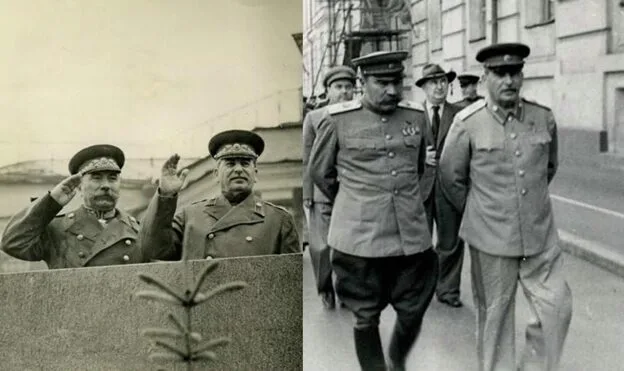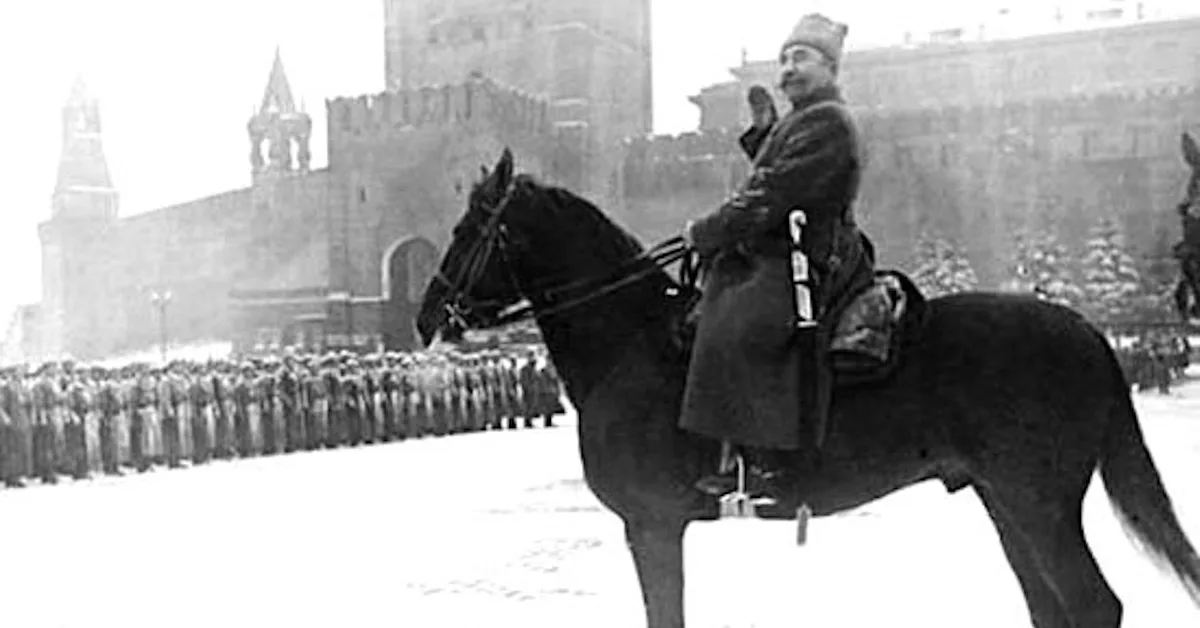On the Internet you can find a story about how a famous Soviet military leader repelled an attempt to arrest him at his dacha during the years of repression. We have verified the accuracy of this story.
According to the plot, during the years of the Great Terror, when, among others, influential party figures were arrested, it was Semyon Budyonny’s turn. When the “black funnel” arrived at his dacha, the marshal placed one or more machine guns through the windows and, according to different versions, either he himself began to shoot, or he ordered his orderlies to do so. After this, Budyonny called Stalin on the phone and said that “the enemies want to capture him.” He held out for half an hour until a second car drove up to the dacha and the people sitting in it stopped their colleagues. In another variation of the story, instead of a machine gun, it appears gun.
They wrote about this “Arguments and facts", "Komsomolskaya Pravda", some entertaining sites, and also users social networks. The episode was shown in the serial film "Son of the Father of Nations"
Semyon Budyonny - one of the creators of the Soviet cavalry, who commanded the First Cavalry Army during the Civil War. Marshal and three times Hero of the Soviet Union went down in history as the person who gave his name headdress, and owner of famous mustache. Despite the lack of secondary education, for many years he held high positions in the state hierarchy.
“Verified” did not find any mention of the action-packed story about the attempt to arrest Budyonny in more or less authoritative biographical sources of the Soviet period, such as the book from the series “Life of wonderful people"(1983), written by Budyonny's senior adjutant Alexander Zolototrubov, as well as the marshal's own memoirs entitled "Distance traveled"(vol. 1 - 1958, vol. 2 - 1965, vol. 3 - 1973). It’s not in the commander’s biography on the website either. Russian Military Historical Society, as well as on the websites of museums dedicated to Great Patriotic war.
As an analysis of sources shows, this case began to appear in the Soviet press only during the years of perestroika. One of the earliest such examples is Yuri Borev’s book “Staliniad” (1990), based on “parables, legends and apocrypha” associated with Stalin. It is as one of the many tales that this story appears there along with comic details.
“In the second half of the 30s, cars drove up to Budyonny’s country house. The capture group quickly jumped out of them and surrounded the dacha. The Marshal ordered his orderlies and adjutants to take up all-round defense. Machine guns were placed in the windows, from which they opened fire. The arrivals lay down, hiding behind the trees. Budyonny himself ran to the phone and reported the situation to Stalin. Stalin asked:
- Can you hold out for half an hour?
- I think I can hold out.
- Fine.Half an hour later another car arrived and the guests were called away. Stalin called Budyonny and, having learned that everything was in order, said:
- And hand over the machine guns.
Budyonny handed over two machine guns, but still left four in the attic.”
In the 1990s, this story actively spread throughout different books And periodicals, however, from a historical point of view there are many questions about this story.
In the 1930s, Budyonny, along with another commander, Kliment Voroshilov, became one of Stalin’s main supporters in the matter of purges in the political and military ranks. Unlike some Soviet leaders, he did not oppose collectivization, one of the consequences of which was hunger, which claimed the lives of several million people. At the February-March plenum of the Central Committee of the All-Union Communist Party of Bolsheviks in 1937, which heralded the beginning of the Great Terror, Budyonny actively participated in the discussion of the cases of Nikolai Bukharin and Nikolai Rykov, assented stigmatizing them to other party leaders, voted for their expulsion from the party, trial and execution. In the same year, the marshal was one of the judges in the trial of the anti-Soviet Trotskyist military organization - a group of senior Soviet military leaders led by Marshal Mikhail Tukhachevsky, which was fabricated accused of organizing a military conspiracy to seize power. As a result, all the defendants (except for Yan Gamarnik, who committed suicide on the eve of his arrest) were convicted and immediately shot, and Budyonny in his letter People's Commissar of Defense Voroshilov called them patent spies who “from the point of view of courage made a very pitiful impression” and “looked like insignificant wimps.”
All these efforts, of course, did not guarantee Budyonny protection from repression. Many of the active participants in the Great Terror were also subsequently shot on various charges. However, there is not at least one convincing evidence that Budyonny himself was seriously threatened with arrest. Yes, in August 1937, his second wife, an actress, was arrested and subsequently exiled to the Krasnoyarsk Territory Olga Mikhailova, who was accused of espionage and relations with foreigners. However, Stalin himself, and subsequently the head of the NKVD Nikolai Yezhov, spoke about suspicions against her to the marshal in a confidential conversation, and in no way, judging by Budyonny’s memoirs, did not hint at the danger for the military leader himself.
Moreover, the security forces, for their part, were definitely collecting dirt on Budyonny. According to certificate Third Directorate of NGOs of the USSR, engaged in the fight against counter-revolution, espionage and other anti-Soviet manifestations, after 1937, the ex-deputy People's Commissar of Defense of the USSR, Marshal Alexander Egorov, the commanders of the Leningrad, North Caucasus, Trans-Baikal military districts, the Primorsky group of troops of the Special Red Banner Far Eastern Army, the Baku Air Defense Region, several other high-ranking personnel from the Red Army and his wife testified against Budyonny Budyonny himself Olga. According to this testimony, he led the “anti-Soviet organization of the right” in the Red Army and prepared counter-revolutionary formations for the uprising, consisting of Cossacks loyal to him since the Civil War.
These are very serious accusations, and in those years, even in much less acute situations, repressions, as a rule, were not long in coming. Most of those who testified were shot, so they could no longer retract their words. However, Budyonny not only remained free - he was one of the key figures in the security bloc even after the end of the Great Terror: he commanded the Moscow Military District, and during the war he hosted parade November 7, 1941 on Red Square, entered to the Headquarters of the Supreme High Command, did not fall into disgrace even after failed leadership first of the Reserve Front, and then of the North Caucasus. The influence of Budyonny, Georgy Zhukov and Semyon Timoshenko was enough to successfully intercede before Stalin about the release of Konstantin Rokossovsky, who was also arrested in 1937 and spent three years under investigation and torture. All this suggests that Budyonny definitely enjoyed the patronage of Stalin, with whom met back in 1918, during the defense of Tsaritsyn. Budyonny reciprocated this patronage - even after exposing Stalin’s personality cult at the 20th Congress of the CPSU, he never criticized the leader or acknowledged his role in the repressions. By certificate military historian Vasily Polikarpov, who edited the second volume of Budyonny’s memoirs in the early 1960s, in response to criticism of the bias of his assessments of a number of repressed figures, the marshal first called them Trotskyists, and then began to justify his participation in their case by order of Stalin.

Considering that the arrests of high-ranking officials were usually carried out with the knowledge of Stalin, the likelihood of such a visit to Budyonny’s dacha can be considered minimal.
Budyonny’s closest people—his children—could know better than most biographers whether this story actually happened. In 2021, Budyonny's daughter Nina program “The Fate of a Man with Boris Korchevnikov”, when asked about the authenticity of the story, stated: “A legend, of course. Tale. There was no such thing." Much earlier, writer and military journalist Alexander Bondarenko met with Nina’s older brother Mikhail. He gave a more detailed answer: “This story dates back to the Khrushchev period, to the time when Nikita Sergeevich kicked his father out of the army... We were returning from exercises, and Timoshenko, and with him there was another comrade, invited him to his carriage. We sat. My father made a toast to the Presidium of the CPSU Central Committee, they drank, and then he said: “I believe in the Presidium as a body, but not in each member of the Presidium individually.” How Nikita Sergeevich found out about this is anyone’s guess. My father was assigned to the Inspector General Group, an honorable marshal's discharge. But let’s return to the anecdote... After shooting, my father called Stalin, who asked: “Why didn’t you hand over these weapons after the Civil War?” And Semyon Mikhailovich replies: “If you send anyone else, I’ll open a little fluff!”… There’s also this anecdote: they report to their father that an attempt was made on Nikita Sergeevich’s life; they shot at him with a pistol. “Why didn’t you try a checkerboard?” - Budyonny asked. This is from the same series... So don't believe the rumors. Although Semyon Mikhailovich was later shown 12 volumes of incriminating evidence against him. They were going to collect it, but they were afraid to touch it. There was cavalry around Moscow at that time, and it is unknown how it would have ended... Stalin understood that anyone would have given their life for Budyonny.”
Thus, in all likelihood, the popular story about Budyonny, who shot back at NKVD agents at his dacha, is a historical anecdote. Both the marshal’s children and the realities of those years speak about this. At the same time, there could be prerequisites for the appearance of the joke - according to certificate writer Boris Raskin, in one of the television interviews, Budyonny’s granddaughter Anastasia confirmed that her grandfather actually had a machine gun at the dacha and is still buried somewhere there. There are others mentions this fact.
Cover photo: social networks
Read on topic:
- Is it true that in the photo is the first wife of Dmitry Peskov and the granddaughter of Marshal Budyonny?
- Is it true that the drunken Marshal Bulganin forced the generals to kiss the pantaloons of the ballerinas?
- Did Zhukov say that Bandera’s hatred of Russians is a coward’s revenge for the fear he experienced?
If you find a spelling or grammatical error, please let us know by highlighting the error text and clicking Ctrl+Enter.






